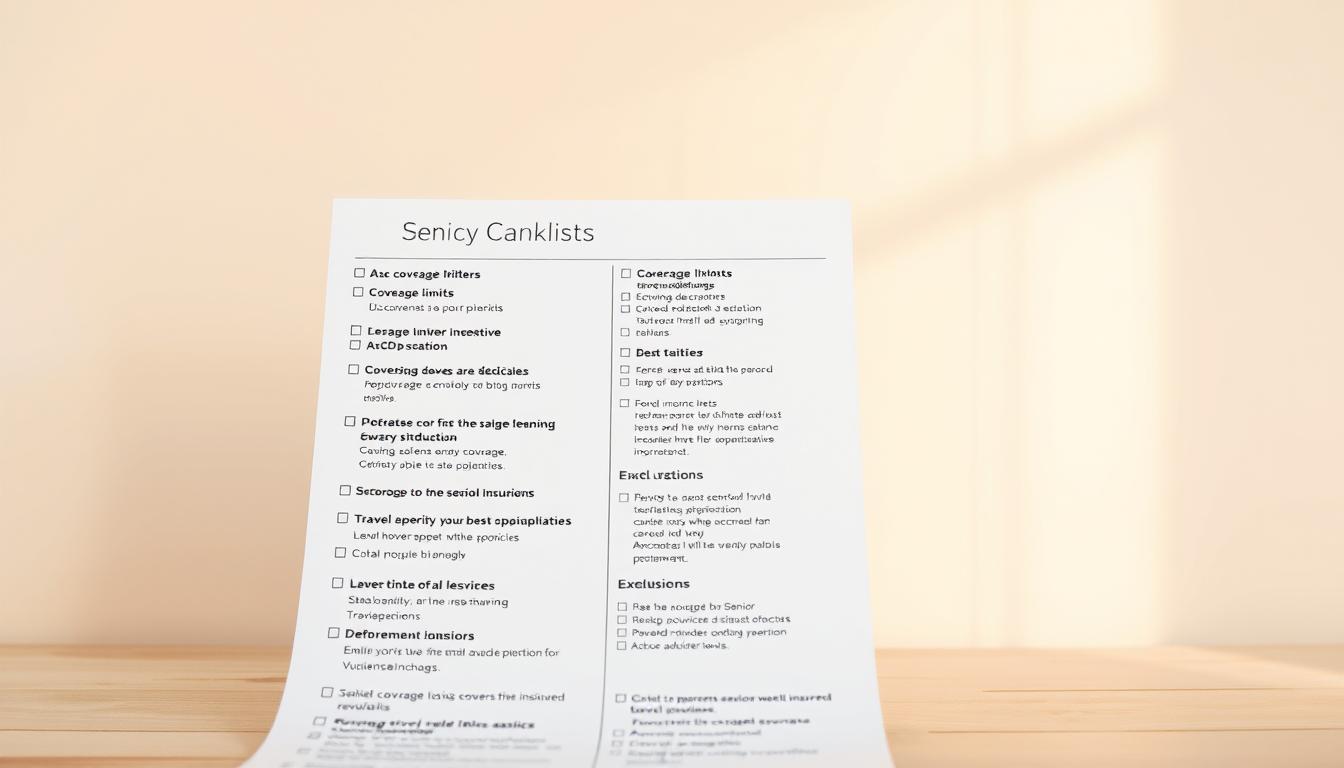Dreaming of exploring new destinations but worried about unexpected health issues abroad? You’re not alone. Finding the right coverage becomes more important as we age, especially with higher risks of medical emergencies far from home. This guide is your roadmap to staying protected—so you can focus on making memories, not managing stress.
We’ve analyzed over 100 policies from trusted providers like IMG, Tin Leg, and Seven Corners. Our research shows emergency medical coverage should start at $100,000, with $250,000 for medical evacuation—critical safeguards for international trips. Whether you’re managing pre-existing medical conditions or navigating policy exclusions, we’ll simplify the details.
Think of this as your go-to resource for comparing plans, understanding costs, and spotting hidden gaps. Let’s ensure your next adventure is as safe as it is exciting.
Understanding the Importance of Senior Travel Insurance
Later years are perfect for discovery, yet health risks can turn a trip upside down. Having the right safeguards ensures you’re prepared for the unexpected, letting you focus on experiences rather than worries.
Why Coverage Is Essential
Many older adults manage pre-existing medical conditions like diabetes or heart issues. These require consistent care, even abroad. A sudden flare-up or accident—like chest pains during a hike or a slip on cobblestones—can lead to costly hospital stays. Without coverage, you might pay thousands out-of-pocket for treatments your home policy won’t cover.
Risks and Potential Unplanned Expenses
Overseas medical bills add up fast. For example, treating a broken leg abroad can cost over $20,000. Chronic issues like arthritis or asthma might worsen with altitude changes or unfamiliar climates. A robust insurance plan handles emergencies and routine care, from prescription refills to specialist visits.
Choosing the right policy means fewer surprises. It’s not just about protection—it’s about enjoying your journey knowing you’re covered, even if the unexpected happens.
Key Benefits and Features for Travel Insurance Seniors
Exploring new cultures and landscapes should be exciting, not stressful—especially when health or logistics go sideways. The best plans offer layers of protection tailored to common challenges abroad. Let’s break down two pillars of reliable coverage.
Emergency Medical and Evacuation Coverage
Medical emergencies don’t wait for convenient moments. A heart issue in Paris or a fall in Tokyo could require urgent care. Policies with at least $100,000 for medical treatment handle hospital bills, while $250,000 evacuation coverage ensures swift transport to quality facilities. This dual safeguard is vital—local hospitals might lack specialized equipment, and evacuation flights can cost six figures.
Trip Cancellation and Delay Protections
Life’s unpredictability doesn’t respect itineraries. If a family emergency or severe weather cancels your plans, reimbursement for non-refundable flights and hotels softens the blow. Delays exceeding 6-12 hours often trigger payouts for meals and lodging.
These features let you book trips confidently, knowing upfront costs aren’t lost to unforeseen events. Together, these benefits create a safety net that lets you savor every moment. Whether wandering European markets or hiking Machu Picchu, robust coverage keeps the focus on adventure—not what-ifs.
Comparing Top Providers and Insurance Plans for Seniors
Choosing the right coverage doesn’t have to feel like deciphering a foreign language. Squaremouth’s sales data reveals three standout options for older travelers: IMG, Tin Leg, and Seven Corners. Each shines in specific areas, from emergency support to budget-friendly pricing.
Provider Strengths at a Glance
IMG leads with well-rounded protection. Their iTravelInsured Choice plan includes $500,000 for medical evacuation—double the industry standard. Tin Leg’s Luxury option cuts costs by 30% on average while covering trip interruptions up to 150% of your investment. Seven Corners prioritizes health needs, offering $1 million in medical coverage for complex cases.
| Provider | Emergency Medical | Pre-Existing Conditions | Trip Cancellation |
|---|---|---|---|
| IMG | $500,000 | Waiver available | 100% reimbursement |
| Tin Leg | $250,000 | Limited coverage | 150% for delays |
| Seven Corners | $1,000,000 | Full waiver | 75% reimbursement |
What the Numbers Reveal
Over 65% of Squaremouth users over 60 pick IMG for its 24/7 emergency line and straightforward claims. Seven Corners appeals to those managing chronic issues—their policies cover specialist consultations without deductibles. Tin Leg wins for shorter trips, with plans starting under $50 for week-long U.S. travel.
When comparing, prioritize response times for emergencies and clarity on condition waivers. The right plan balances cost with peace of mind, letting you wander freely knowing you’re protected.
Coverage Considerations for Pre-Existing Medical Conditions
Managing health needs while abroad doesn’t have to derail your plans. With the right safeguards, you can address flare-ups confidently and keep your journey on track. Let’s explore how specialized coverage options work for chronic health concerns.
Understanding Pre-Existing Condition Waivers
A pre-existing condition waiver acts like a safety net. It ensures costs from sudden symptom spikes—like unstable blood pressure or joint inflammation—are covered if you meet specific criteria. Most policies require purchasing coverage within 14-21 days of booking your trip to activate this benefit.
These waivers simplify claims for recurring issues. For example, if arthritis pain flares during a cruise, your policy could cover physical therapy sessions abroad. Always verify timelines with providers—missing deadlines might leave you responsible for bills.
Protecting Against Medical Flare-Ups Abroad
Look for plans covering both emergencies and routine care. A robust policy might include prescription refills, specialist visits, or even telehealth consultations. Without this, a diabetic needing insulin adjustments overseas could face steep out-of-pocket fees.
Here’s how to stay prepared:
- Compare options offering $50,000+ for chronic condition treatment
- Confirm coverage for follow-up care after hospital visits
- Check if your plan includes 24/7 medical guidance hotlines
Choosing wisely means fewer financial surprises. You’ll focus on recovery, not costs, if health challenges arise mid-trip.
Budgeting and Cost Factors in Travel Insurance Plans
Smart budgeting turns travel dreams into affordable realities—let’s break down the numbers. We’ve crunched the data: comprehensive protection averages $28 daily, with total costs often landing between $400-$450 based on your selections. Your age, trip length, and chosen safeguards all shape the final price tag.
Three key factors influence costs:
- Age: Older travelers often see higher premiums due to increased health risks
- Trip duration: A two-week journey costs 40-60% more than a 7-day trip
- Coverage limits: Raising medical maximums from $50k to $100k can add $75-$100 to your total
Optional add-ons like luggage replacement or injury-related evacuation boost prices but provide critical safeguards. Annual plans slash costs by 20-30% for frequent explorers—ideal for retirees taking multiple trips yearly.
Balance savings with security by prioritizing coverage limits that match your health needs. If managing a chronic condition, allocate more budget for higher medical maximums. Always compare policies side-by-side—sometimes paying slightly more upfront prevents massive bills later.
Insuring International Adventures: Beyond Domestic Coverage
What happens if you need urgent care halfway across the globe? Domestic health plans often stop at the border, leaving you vulnerable to steep costs. Understanding these gaps helps you build stronger safeguards for overseas journeys.
Navigating Medicare Limitations Abroad
Medicare rarely covers care outside U.S. territories. A broken bone in Italy or food poisoning in Thailand could mean paying $15,000+ out of pocket. Even supplemental plans typically exclude international emergencies, making specialized coverage essential.
Look for a provider that includes repatriation—returning you to your home country for treatment. This service alone can cost $200,000 without protection. Policies should also address local restrictions, like limited hospital networks or required upfront payments.
Annual Versus Single-Trip Insurance Options
Frequent explorers save 25-40% with annual plans covering unlimited trips under 30-90 days. These streamline paperwork and ensure continuous protection. Occasional travelers benefit from single-trip policies tailored to specific destinations and activities.
| Feature | Annual Plan | Single-Trip |
|---|---|---|
| Best For | 3+ trips yearly | One-off journeys |
| Cost Efficiency | Higher upfront, lower per-trip | Pay-as-you-go |
| Coverage Limits | Per-incident caps | Total trip maximums |
| Baggage Protection | Often included | Add-on option |
Consider trip frequency and emergencies likely in your destinations. Annual plans simplify logistics but may have per-trip duration restrictions. Single-trip options let you customize baggage coverage or adventure sports add-ons.
Tips for Purchasing Travel Insurance for Seniors
Securing your journey starts with strategic decisions. Timing and attention to detail make all the difference when selecting coverage. Let’s walk through key steps to maximize protection while avoiding common pitfalls.
Timing Your Purchase and Securing Pre-Trip Benefits
Lock in coverage within 14 days of booking your trip. This activates time-sensitive perks like Cancel For Any Reason (CFAR) reimbursements and pre-existing condition waivers. Early buyers often save 10-15% compared to last-minute shoppers.
| Purchase Timing | Benefits Available | Why It Matters |
|---|---|---|
| At booking | CFAR, pre-existing waivers | Full access to premium features |
| 1 week after | Basic medical coverage | Miss key protections |
| 3 weeks after | Limited options | Higher costs, fewer choices |
Reviewing Policy Exclusions and Additional Benefits
Always check what’s not covered. Many policies exclude high-risk activities like zip-lining or scuba diving unless you add adventure sports riders. Compare plans using tools like Squaremouth to spot gaps in evacuation limits or prescription coverage.
| Common Exclusions | Covered Scenarios | Check For |
|---|---|---|
| Extreme sports | Guided tours | Activity-specific riders |
| Alcohol-related incidents | Accidental injuries | 24/7 assistance lines |
| Pandemics | Individual illnesses | Crisis coverage add-ons |
Discuss your itinerary with specialists—they’ll help tailor plans to your needs. Whether you’re cruising Alaska or hiking Peru, proper preparation lets you explore with peace of mind.
How to Choose the Right senior travel insurance Coverage
Navigating policy options feels overwhelming? Let’s simplify your search with actionable steps. Start by securing protection within 14 days of booking to unlock critical benefits like pre-existing condition waivers. This timing ensures you’re eligible for the broadest safeguards.
Key Questions to Ask Providers
Always clarify these details before committing:
- “What’s the maximum payout for emergency hospital stays or medical evacuations?”
- “Does this plan cover non-refundable trip costs if I cancel due to a family crisis?”
- “Are there geographic restrictions for international claims processing?”

Providers should explain coverage limits in plain language. If they can’t define “bedside companion coverage” or “trip interruption triggers,” consider other options.
Decoding the Fine Print
Scrutinize exclusions related to activities or health history. Many plans exclude chronic condition flare-ups unless you purchase travel medical insurance with specific riders. Compare policies using this checklist:
| Coverage Aspect | Ideal Policy | Red Flags |
|---|---|---|
| Emergency Evacuation | $500,000+ | Excludes high-risk regions |
| Trip Cancellation | 100% reimbursement | Requires 48-hour delay |
| Pre-Existing Conditions | Waiver included | 60-day lookback period |
Prioritize plans offering 24/7 multilingual support. This ensures quick assistance if pharmacies abroad don’t stock your medication or flights get rerouted. Remember: thorough research today prevents stressful surprises tomorrow.
Conclusion
Your next adventure deserves peace of mind—and the right safeguards make it possible. We’ve walked through the essentials together: prioritizing medical coverage that handles emergencies abroad, comparing providers like IMG and Seven Corners, and understanding how trip duration affects costs.
Remember, timing matters. Locking in your travel insurance policy early unlocks critical protections, from pre-existing condition waivers to evacuation support. Review plans carefully—ask about claim response times and activity exclusions before committing.
Tools like Squaremouth simplify comparisons, while specialists help tailor plans to your needs. Whether exploring ancient ruins or cruising coastal towns, robust medical evacuation and treatment limits let you focus on experiences rather than “what-ifs.”
Investing in coverage isn’t just practical—it’s empowering. With a well-chosen plan, you’ll wander confidently knowing you’re prepared. Here’s to unforgettable journeys where the only surprises are the good kind.


